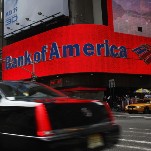'Products for Good Times™': How Playboy Learned to Sell Its Sexy Self
In DepthMost of the attention paid to Playboy Enterprises, Inc. over the years has revolved around a few things: the persona of Hugh Hefner, the mansion he lives in, and the magazine he founded. But there’s one thing that makes those parts, if not thrive, then survive, and it’s remarkably simple: the bunny ears logo accompanied by the all-caps PLAYBOY.
Hefner started to look into licensing the Playboy brand almost as soon as his magazine launched in the mid-1950s, at first through calendars and cards, but soon moving into male apparel, like the Alberto Vargas-designed shirt from the 1970s seen at left. It was a natural fit for a publication that from its founding encouraged men to attempt to attain a certain high-class lifestyle, emulated by branding decisions many other similar publications would make in years to come. As Steven Watts explained in his book Mr Playboy: Hugh Hefner and the American Dream, the magazine was starting to fall out of popularity (due partially to the growth of its competitors) by the 1980s, and merchandising was the way Playboy Enterprises made most of its consistent money. And while Hefner, his house, and his magazine might continue to make headlines, they’ve only been able to do so because of the licensing of his logo.
From a 1981 Globe and Mail article:
Counting on the high profile of its rabbit-head symbol, reputed to be the second most recognized logo in the world (preceded only by Coca Cola), Playboy Licencing has introduced a full line of men’s apparel and accessories. Designed to find a niche somewhere between designer names and mass-market brands, the line includes everything from tailored clothing to shoes to robes to jewelry and sunglasses. There’s even a selection of jock socks in five styles named Judy, Carol, Debbie, Robin and Cathy.
Spurred on by the insignia craze, and by the success of Playboy briefs which have racked up more than $4-million in sales during the past two years, Playboy felt the time was ripe to enter the men’s wear market on a wider scale. “We’d like to give Lacoste’s alligator a run for the money,” says Mort Gordon, who is in charge of the licencing efforts in both the United States and Canada.
It’s a bold move to say you’re trying “to give Lacoste’s alligator a run for the money.” But by all accounts, the company did it, perhaps to its own detriment: the bunny ears—designed by Art Paul—have become more popular than the content they represent. According to other articles from the period, the company then moved into sportswear and women’s apparel for the first time during this decade. From the Chicago Tribune in 1986:
The licensing business was once a neglected segment of the company that arranged for cheap plastic key chains, T-shirts, car air fresheners and other souvenir-type goods that promoted the magazine and its rabbit-head logo. These days, the segment has licensed the manufacture of a wide range of apparel and other consumer goods, all of which generated worldwide retail sales volume of $240 million in fiscal 1986.
“It’s a little ironic. For more than 30 years, we’ve stood for not having a lot of clothes on people. Now we’re doing well by putting people back in clothes,” said A. William Stokkan, president of Playboy’s licensing and merchandising group.
Stokkan said his group’s strategy is “class in the mass,” products sold in mass-merchandise outlets but designed with more fashion and color and sold at somewhat higher prices than the ordinary store fare.
“We’re not trying to be Calvin Klein reaching Fifth Avenue or Rodeo Drive,” Stokken said at the time.
How things would change: in the coming years, the company would expand their licensing to a range of products, before eventually trying to refocus and sell things at a higher price points ala Fifth Avenue or Rodeo Drive. When Hefner’s daughter Christie Hefner took over as chairman of the board and CEO in 1988, she ramped up this money-making venture, dividing the company into four sections, according to Watts: “publishing, entertainment, product marketing (licensing deals), and catalog sales. This array of products and creations, the company hoped, would promote a modern Playboy lifestyle associated with tasteful ‘consumer sexiness.’”
This overall approach inspired PEI to purchase the duPont Registry, a guide for buying and selling elite cars; Sarah Coventry, a company that featured inexpensive but fashionable jewelry and accessories; and the Critics Choice home video catalog. Searching for a successful formula to strengthen the Playboy Channel—it had been opposed by local fundamentalist groups, but also dropped by many subscribers when they discovered the explicit sex has been deleted from its erotic movies—a pay-per-view format was adopted. PEI also made a strong move into global markets with new foreign editions of Playboy and a wide variety of licenses products, videos, and pay-per-view. In order to take advantage of advancing telecommunications technology, the company expanded into electronic publishing and sales, opening a free Web site in 1994, a Cyber Club and an online Playboy Store in 1997, and a partnership with K-Tel to create an online music store.
Once Playboy’s licensing section was really up and running, they tried it all, as the catalogs the magazine sent to subscribers in the ‘90s demonstrate, which look essentially like SkyMall for men. For instance, here’s Fall/Winter 1990, whose tagline read “Products for Good Times™.” The catalog sold everything from deodorant crystals to body tattoos to men’s zebra briefs, though as the Tribune article from several years earlier foreshadowed, Playboy’s being torn between “two audiences”—one labeled as upscale, one as downscale—would become a branding issue the company has only really tried to grapple with in the past few years.
It’s their message t-shirts that definitely speak to what the brand would be synonymous with in the 1990s and 2000s, and what they’d struggle to shake. There’s an inherent cheesiness to these products, which paved the way for the tiny pink t-shirts bejeweled with the bunny logo that Hef’s girlfriends on The Girls Next Door (and subsequently a generation of young women) would eventually be seen sporting.
The catalog also sold lots of legitimately sex-related products—dozens of VHS tapes like Sexy Lingerie II Video, a 50 minute video that cost $19.99…
-

-

-

-

-

-

-

-

-

-

-

-

-

-

-

-

-

-

-

-

-

-

-

-

-

-

-

-

-

-

-

-

-

-

-

-

-

-

-

-








































